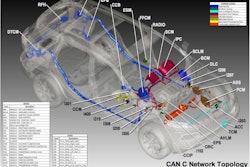 A FedEx Ground sorting facility
A FedEx Ground sorting facilityAre robo-trucks already taking drivers off the road? It’s a possibility, though an indirect one, suggests Fred Andersky, director of government and industry affairs for Bendix Commercial Vehicle Systems. And truck-driving jobs won’t be the only ones impacted by technological changes coming to the supply chain.
CCJ had a couple of long chats with Andersky following the recent House hearing on autonomous vehicles because, well, self-driving vehicles are fun to imagine. And while the hearing was perhaps a little premature, it’s better that policy makers and regulators keep up with the possibilities rather than fall behind and inhibit innovation.
The hearing also served a broader, more timely purpose: keeping Congress informed about the impressive safety technologies that are available here and now.
Indeed, technology develops and becomes accepted through a series of steps; although revolutionary innovation certainly can capture headlines and the imagination, even self-driving cars and trucks will not be a shock to the public by the time they’re widely available.
“As you look at the how commercial vehicle safety technologies have evolved – from ABS (antilock braking systems) to ESC (electronic stability control) to ACC (adaptive cruise control) and now to CMS (collision mitigations systems) – each new technology has built on the previous, delivering expanded capabilities and more robust interventions,” says Andersky. “I do think the real value in moving forward with autonomous vehicle research, as well as the efforts on the Intelligent Transportation System, ties to supporting the continuing evolution of active safety technologies.”
We discussed the technical, social and political steps on the road to self-driving vehicles in a previous post, but today’s topic is “what if?”
Andersky’s got an interesting starting spin: Does just the looming prospect of autonomous vehicles exacerbate the driver shortage?
“Trucking talks about the need to get younger folks to consider truck driving as a career. Why would someone get into a career that is going to be phased out in possibly 20 or 30 years – right at the point when they need the job to help with kids in college or planning for retirement?” Andersky says. “Does a shrinking pool of folks interested in driving as a career hasten the need for autonomous trucks? We end up with the self-fulfilling prophecy: We need to move to autonomous vehicles because we don’t have enough drivers to carry the load.”
And I do agree that a shrinking driver pool could increase demand for automation, but I’ll offer a glass half-full suggestion: Younger drivers are going to love every technological gadget truck makers can throw at them, and the idea of manning the controls of the coolest rig this side of the starship Enterprise will attract young people to the trucking industry. Indeed, few jobs these days are immune to becoming obsolete in a decade or two and young people know this.
What happens to truck drivers when autonomous vehicles do arrive?
“The policy implications around autonomous vehicles, and their impact on truck drivers, taxi drivers, package delivery drivers, bus drivers, chauffeurs, etc. are pretty broad,” Andersky says. “I would have to think that any legislation/regulation around autonomous vehicles would have to take this implication into consideration; meaning there could be requirements that, like pilots in airplanes, we’ll see a need to keep a driver behind the wheel for a long time. Not necessarily because he or she needs to be there, but because there’s not another job to move into or to help ease the transition into other careers.”
More broadly, and more likely, Andersky envisions a redesign for the transportation system: more use of high-speed autonomous trains to more terminals with very short-haul delivery trucks (with or without drivers) covering the last mile. “Wouldn’t this be a logical first step in an autonomous logistics system, since rail is almost a closed-loop environment and you might avoid many of the societal concerns of autonomous vehicles on roadways?” Andersky says. “When it comes down to it, we can’t really have a conversation about autonomous trucks without taking into consideration autonomous advancements in other modes of our logistics system.”
Indeed, that’s where this is heading: a largely automated supply chain. Anyone who’s toured a FedEx Ground sorting facility has seen packages flowing by the thousands through a maze of conveyors, scanners and chutes, to be touched by human hands only when the trucks are loaded and unloaded.
Or have a look at this FedEx video. First note all of the automation that’s been developed since FedEx started in Memphis 40 years ago, then try imagine 40 years from now. Or even 10: Will those ground shuttles need drivers? Or will planes with no passengers need pilots?
[youtube iYzQ7JSBIGU nolink]
“I think one thing is for certain,” Andersky concludes. “We’ll be talking about the implications – societal, technological, political and economic – of autonomous commercial vehicles and implications for our freight system for a long time to come!”











